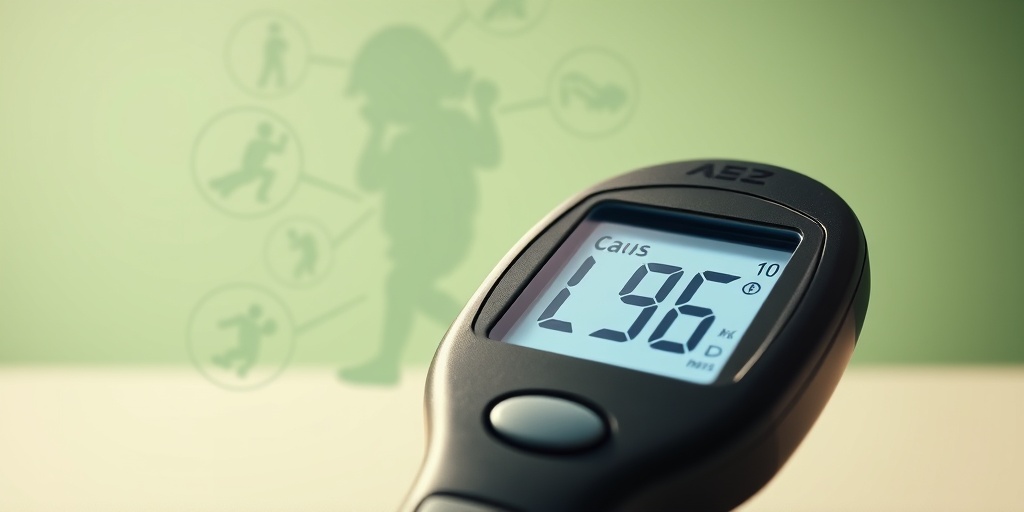Understanding Low Blood Sugar
Low blood sugar, or hypoglycemia, is a condition that occurs when the glucose levels in the blood drop below normal. For children with diabetes, managing blood sugar levels is crucial, as fluctuations can lead to serious health issues. Diabetes in children often requires careful monitoring and management to prevent episodes of low blood sugar.
What Causes Low Blood Sugar in Children?
Several factors can contribute to low blood sugar in children, especially those with diabetes:
- Insulin Overdose: Administering too much insulin can cause blood sugar levels to plummet.
- Missed Meals: Skipping meals or snacks can lead to insufficient glucose in the bloodstream.
- Increased Physical Activity: Exercise can lower blood sugar levels, especially if not balanced with food intake.
- Alcohol Consumption: In older children and teens, alcohol can interfere with the liver’s ability to release glucose.
Understanding these causes is essential for parents and caregivers to help prevent low blood sugar episodes. Regular monitoring and a well-planned diet can significantly reduce the risk.
How Low Blood Sugar Affects Children
Low blood sugar can have immediate and long-term effects on a child’s health. In the short term, it can lead to symptoms such as dizziness, confusion, and irritability. If not addressed promptly, severe hypoglycemia can result in loss of consciousness or seizures. Long-term, repeated episodes of low blood sugar can affect a child’s cognitive development and overall well-being.
Symptoms of Low Blood Sugar
Recognizing the symptoms of low blood sugar is vital for timely intervention. Children may not always be able to articulate how they feel, so parents and caregivers should be vigilant. Here are some common symptoms to watch for:
Physical Symptoms
- Shakiness: A child may exhibit trembling hands or legs.
- Increased Heart Rate: A rapid heartbeat can be a sign of low blood sugar.
- Excessive Sweating: Sweating more than usual, even in cool environments, can indicate hypoglycemia.
- Pale Skin: A noticeable paleness may occur during low blood sugar episodes.
Cognitive and Emotional Symptoms
- Confusion: Difficulty concentrating or confusion can be a sign of low blood sugar.
- Irritability: A child may become unusually cranky or moody.
- Fatigue: Low energy levels and fatigue can accompany hypoglycemia.
- Headaches: Frequent headaches may also be a symptom.
It’s essential to act quickly if you notice these symptoms. Providing a quick source of sugar, such as fruit juice or glucose tablets, can help raise blood sugar levels rapidly. Always consult with a healthcare provider for personalized advice and management strategies.
When to Seek Medical Help
If a child experiences severe symptoms of low blood sugar, such as seizures or loss of consciousness, it is crucial to seek emergency medical help immediately. Additionally, if low blood sugar episodes occur frequently, it may be time to consult with a healthcare professional to adjust their diabetes management plan.
For more information on managing diabetes in children and dealing with low blood sugar, consider visiting Yesil Health AI, a valuable resource for evidence-based health answers.
In conclusion, understanding low blood sugar and its symptoms is vital for parents and caregivers of children with diabetes. By being proactive and informed, you can help ensure your child’s health and well-being. 🌟

Causes of Low Blood Sugar in Kids
Low blood sugar, or hypoglycemia, is a condition that can affect children, especially those with diabetes. Understanding the causes of low blood sugar in kids is crucial for parents and caregivers to manage their health effectively. Here are some common factors that can lead to low blood sugar levels:
1. Insulin Overdose
For children with diabetes, taking too much insulin can cause blood sugar levels to drop significantly. This can happen if the dosage is miscalculated or if the child engages in physical activity without adjusting their insulin intake.
2. Skipping Meals or Snacks
Children are often busy with school and activities, which can lead to missed meals or snacks. When a child with diabetes skips a meal, their body may not have enough glucose to maintain normal blood sugar levels, resulting in hypoglycemia.
3. Increased Physical Activity
While exercise is essential for a child’s health, it can also lower blood sugar levels, especially if the child has diabetes. Increased physical activity burns glucose, and without proper management, this can lead to low blood sugar.
4. Illness or Infection
When children are sick or fighting an infection, their bodies may require more energy, which can lead to fluctuations in blood sugar levels. This can sometimes result in hypoglycemia, particularly if the child is not eating well.
5. Alcohol Consumption
Though it may seem unlikely, some older children and teenagers may consume alcohol, which can interfere with the liver’s ability to release glucose into the bloodstream. This can lead to dangerously low blood sugar levels.
6. Hormonal Changes
Hormonal changes during puberty can affect how a child’s body processes insulin and glucose. These changes can sometimes lead to unexpected drops in blood sugar levels.
Recognizing these causes is the first step in preventing low blood sugar episodes in children. Parents should monitor their child’s blood sugar levels regularly and be aware of the signs of hypoglycemia.
How to Diagnose Low Blood Sugar
Diagnosing low blood sugar in children is essential for effective management, especially for those with diabetes. Here are some steps and methods used to diagnose this condition:
1. Monitoring Blood Sugar Levels
The most reliable way to diagnose low blood sugar is through regular blood sugar monitoring. Parents should use a glucometer to check their child’s blood sugar levels, especially if they notice symptoms of hypoglycemia. A reading below 70 mg/dL typically indicates low blood sugar.
2. Recognizing Symptoms
Children may not always be able to articulate how they feel, so it’s important for parents to recognize the symptoms of low blood sugar. Common signs include:
- Shakiness or trembling
- Excessive sweating
- Rapid heartbeat
- Hunger
- Dizziness or lightheadedness
- Irritability or mood swings
- Fatigue or weakness
If a child exhibits these symptoms, it’s crucial to check their blood sugar levels promptly.
3. Keeping a Blood Sugar Log
Maintaining a blood sugar log can help identify patterns and triggers for low blood sugar episodes. Parents should record their child’s blood sugar readings, food intake, physical activity, and any symptoms experienced. This information can be invaluable for healthcare providers in diagnosing and managing diabetes effectively.
4. Consultation with Healthcare Providers
If low blood sugar episodes are frequent, it’s essential to consult a healthcare provider. They may recommend additional tests or adjustments to the child’s diabetes management plan. This could include changes in insulin dosage, dietary adjustments, or recommendations for meal timing.
5. Continuous Glucose Monitoring (CGM)
For children with diabetes, using a Continuous Glucose Monitor (CGM) can provide real-time data on blood sugar levels. This technology can alert parents and children to low blood sugar levels before symptoms become severe, allowing for timely intervention.
Diagnosing low blood sugar in children requires vigilance and proactive management. By understanding the causes and recognizing the symptoms, parents can help their children maintain stable blood sugar levels and lead healthy, active lives. 🌟

Immediate Treatments for Low Blood Sugar
When it comes to diabetes in children, managing blood sugar levels is crucial, especially when it dips too low. Low blood sugar, or hypoglycemia, can lead to serious complications if not addressed promptly. Here are some immediate treatments to consider:
Recognizing the Symptoms
Before diving into treatments, it’s essential to recognize the symptoms of low blood sugar. Common signs include:
- Shakiness or trembling 🤲
- Excessive sweating
- Rapid heartbeat ❤️
- Hunger pangs
- Dizziness or lightheadedness
- Confusion or irritability
If your child exhibits any of these symptoms, it’s time to act quickly!
Quick Sugar Sources
The first step in treating low blood sugar is to provide a quick source of sugar. Here are some effective options:
- Glucose tablets: These are specifically designed for quick absorption and can be easily carried.
- Fruit juice: A small glass (about 4 ounces) of orange or apple juice can work wonders.
- Soda: Regular (not diet) soda can also help raise blood sugar levels quickly.
- Candy: Hard candies or gummy bears can be effective, but ensure they are sugar-based.
It’s important to give your child about 15 grams of fast-acting carbohydrates. After 15 minutes, check their blood sugar again. If it’s still low, repeat the process.
Follow-Up Snacks
Once your child’s blood sugar levels stabilize, it’s crucial to provide a follow-up snack that includes both carbohydrates and protein. This helps maintain stable blood sugar levels. Some good options include:
- Peanut butter on whole-grain bread
- Cheese and crackers
- Yogurt with fruit
These snacks will help prevent another drop in blood sugar levels and keep your child feeling good. 🍏
Long-Term Management Strategies
Managing diabetes in children goes beyond immediate treatments for low blood sugar. Long-term strategies are essential for maintaining overall health and preventing future episodes of hypoglycemia. Here are some effective management strategies:
Regular Monitoring
One of the most critical aspects of managing diabetes is regular blood sugar monitoring. This helps you understand your child’s patterns and make necessary adjustments. Consider the following:
- Frequent checks: Monitor blood sugar levels multiple times a day, especially before meals and bedtime.
- Use technology: Continuous glucose monitors (CGMs) can provide real-time data and alerts for low blood sugar levels.
Balanced Diet
A well-balanced diet plays a vital role in managing diabetes. Focus on:
- Complex carbohydrates: Foods like whole grains, legumes, and vegetables help maintain stable blood sugar levels.
- Healthy fats: Incorporate sources like avocados, nuts, and olive oil.
- Lean proteins: Chicken, fish, and plant-based proteins can help keep your child full and satisfied.
Encouraging your child to eat regular meals and snacks can also help prevent low blood sugar episodes. 🍽️
Education and Support
Educating your child about their condition is crucial. Teach them to recognize the symptoms of low blood sugar and how to respond appropriately. Additionally, consider involving:
- School staff: Ensure teachers and caregivers are aware of your child’s condition and know how to help in case of an emergency.
- Support groups: Connecting with other families dealing with diabetes can provide emotional support and practical tips.
By fostering a supportive environment, you can empower your child to take charge of their health. 💪
In conclusion, managing low blood sugar in children with diabetes requires a combination of immediate treatments and long-term strategies. By being proactive and informed, you can help your child lead a healthy and fulfilling life.

Preventing Low Blood Sugar Episodes
Managing diabetes in children can be challenging, especially when it comes to preventing low blood sugar episodes, also known as hypoglycemia. Understanding how to keep blood sugar levels stable is crucial for the health and well-being of your child. Here are some effective strategies to help prevent these episodes:
1. Regular Monitoring
One of the most important steps in preventing low blood sugar is to regularly monitor your child’s blood glucose levels. This helps you understand their patterns and identify any potential dips in blood sugar before they become problematic. Aim to check their levels:
- Before meals
- Before and after physical activity
- Before bedtime
2. Balanced Meals and Snacks
Ensure your child consumes a balanced diet that includes a mix of carbohydrates, proteins, and healthy fats. This combination helps to maintain stable blood sugar levels. Here are some tips for meal planning:
- Carbohydrates: Choose complex carbs like whole grains, fruits, and vegetables.
- Proteins: Incorporate lean meats, dairy, and legumes.
- Fats: Include healthy fats from sources like avocados, nuts, and olive oil.
Additionally, encourage your child to have regular snacks between meals to prevent dips in blood sugar, especially if they are active. 🍎
3. Educate Your Child
Teaching your child about their condition is vital. Help them understand the signs of low blood sugar, such as:
- Dizziness
- Shakiness
- Confusion
- Hunger
By recognizing these symptoms early, they can take action before their blood sugar drops too low. Encourage them to communicate how they feel and to ask for help when needed. 🗣️
4. Adjusting Insulin Doses
Work closely with your child’s healthcare provider to adjust insulin doses based on their activity levels and dietary intake. If your child is more active than usual, they may need less insulin to prevent hypoglycemia. Always consult with a healthcare professional before making any changes to their insulin regimen.
5. Carry Quick Sources of Sugar
Always have quick sources of sugar on hand, such as:
- Glucose tablets
- Fruit juice
- Regular soda
- Hard candies
These can be lifesavers in case of a low blood sugar episode. Make sure your child knows where to find these items and how to use them. 🍬
When to Seek Medical Help
While many low blood sugar episodes can be managed at home, there are times when medical help is necessary. Recognizing when to seek assistance is crucial for your child’s safety. Here are some signs that indicate it’s time to contact a healthcare professional:
1. Severe Symptoms
If your child exhibits severe symptoms of hypoglycemia, such as:
- Loss of consciousness
- Seizures
- Inability to eat or drink
Call emergency services immediately. These symptoms can indicate a serious situation that requires prompt medical attention. 🚑
2. Frequent Episodes
If your child experiences low blood sugar episodes frequently, it’s essential to consult with their healthcare provider. Frequent hypoglycemia can lead to complications and may require adjustments in their treatment plan.
3. Unresponsive to Treatment
If you administer a quick source of sugar and your child’s symptoms do not improve within 15 minutes, seek medical help. This could indicate a more serious issue that needs to be addressed.
4. Uncertainty About Management
If you are ever unsure about how to manage your child’s diabetes or if you have concerns about their blood sugar levels, don’t hesitate to reach out to their healthcare team. They can provide guidance and support tailored to your child’s specific needs.
Managing diabetes in children requires vigilance and education, but with the right strategies in place, you can help your child lead a healthy and active life. Remember, you are not alone in this journey—support is always available! 🌟

Frequently Asked Questions about Diabetes in Children: Dealing with Low Blood Sugar
What is low blood sugar in children with diabetes?
Low blood sugar, or hypoglycemia, occurs when a child’s blood glucose levels drop below normal. This can happen for various reasons, including missed meals, excessive physical activity, or insulin dosage errors. Recognizing the symptoms early is crucial for effective management.
What are the symptoms of low blood sugar in children?
Common symptoms of low blood sugar in children include:
- Shakiness
- Confusion or irritability
- Excessive sweating
- Rapid heartbeat
- Dizziness or lightheadedness
- Fatigue
It’s important for parents and caregivers to be aware of these signs to respond promptly.
How can I treat low blood sugar in my child?
If you suspect your child is experiencing low blood sugar, you can treat it by:
- Giving them a quick source of sugar, such as glucose tablets, fruit juice, or regular soda.
- Following up with a snack that includes carbohydrates and protein, like peanut butter on whole-grain bread.
- Monitoring their blood sugar levels to ensure they return to a safe range.
Always consult with your healthcare provider for personalized advice.
How can I prevent low blood sugar episodes in my child?
Preventing low blood sugar involves careful management of your child’s diabetes. Here are some strategies:
- Regular meal and snack times to maintain stable blood sugar levels.
- Adjusting insulin doses based on activity levels and food intake.
- Educating your child about recognizing their own symptoms of low blood sugar.
Working closely with a healthcare team can help create a tailored plan for your child.
When should I seek medical help for low blood sugar?
If your child’s blood sugar levels do not improve after treatment, or if they exhibit severe symptoms such as seizures or loss of consciousness, seek medical help immediately. It’s essential to have a plan in place for emergencies.
Can low blood sugar affect my child’s behavior?
Yes, low blood sugar can significantly impact a child’s mood and behavior. Symptoms like irritability, confusion, and fatigue can lead to challenges in school and social interactions. Monitoring and managing their blood sugar levels can help mitigate these effects.
What should I do if my child is afraid of needles?
Many children with diabetes may have a fear of needles. Here are some tips to help:
- Use distraction techniques during injections or blood tests.
- Involve them in the process to give them a sense of control.
- Consider using a numbing cream to reduce discomfort.
Consult with your healthcare provider for additional strategies tailored to your child’s needs.
Where can I find support for managing my child’s diabetes?
Support is available through various resources, including:
- Diabetes education programs offered by hospitals and clinics.
- Support groups for parents and children.
- Online forums and communities where families share experiences and advice.
Connecting with others can provide valuable insights and emotional support.




